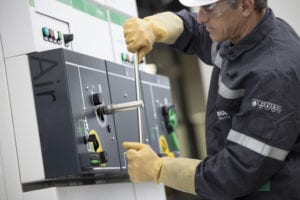Industrial organizations are subjected to a higher level of business risk than ever before. Distribution disruptions, global competition, physical infrastructure vulnerabilities, and safety issues all present growing challenges to production predictability and resilience. According to analyst firm Aberdeen Research, 82% of companies experience unplanned downtime and, depending on the industry, these interruptions can cost a company as much as $260,000 an hour. For these reasons, many manufacturers are searching for new ways to minimize the impact of disruptions through the use of digital solutions such as AI engines.
Predictive AI engines consist of software with imbedded algorithms that use data from multiple sources to steadily build prediction accuracy. Such predictive engines apply themselves to the operation of industrial equipment, to service fulfillment, to physical infrastructure analysis within buildings (i.e., monitoring of power, ventilation and heating and cooling systems), and to human safety.
As organizations grow, their level of operational risk increases (more can go wrong with a larger installed base of equipment, for instance). By analyzing the historical experience of multiple sites surrounding equipment failure and safety incidences, an AI engine can automatically generate a profile of the level of risk that an organization can expect moving forward, and can also generate the probability that a future incident will occur.
Equipped with such information, an organization can pursue multiple paths. First, it can alert workers to the risk and, by making people aware of the risk, can instruct them how to avoid the danger or disruption. Second, it can plan for resource and staff to respond to the failure threat (such as procuring the necessary inventory of spare parts prior to the equipment failure). This type of foresight helps organizations to get back to normal service as quickly as possible, should an incident occur.

How an AI engine digital solution drives business continuity
Our company, Predictive Layer, is a Schneider Electric Technology Partner that supports process and discrete manufacturers who are seeking to forecast equipment performance and safety with higher accuracy and speed. We explain to our clients that generating an accurate profile of an organization’s facilities plays an important role when populating an AI engine with appropriate data. Elements such as geographic uniqueness, the functional mix of employees (i.e., ratio of blue collar to white collar), the number of employees, the physical setup of the site (e.g. number of floors, types of equipment on those floors), business hours (e.g. 24/7 operation), and the types of activities that occur at the sites are all critical. The engine will combine those elements to calculate risks and will incorporate data from other, similar sites and learn from that data.
In addition to site profile information, the history of previous equipment failure and safety incidents is also factored in. By processing this historical data, the AI engine can then start to build a model which generates alerts when the potential risk of critical equipment failure gets too high. This allows the facility to properly pre-provision and pre-staff to quickly respond to the risk in question.
Company size often determines whether external anonymous data needs to be added to the data pool for AI analysis. Very large organizations, for instance, with multiple global sites, can generate enough data within their own walls to sufficiently drive the accuracy of the engine. Smaller organizations, by agreeing to both share and use anonymous data from other similar organizations, can pool enough data to drive value from the AI engine’s predictive capabilities.
AI engines provide organizations with the probability of events such as equipment failures or potential safety breaches. They also provide a view of the nature of the issue and the degree of severity of that issue. The AI engine even has the ability to perform a self-assessment of its predictive capabilities and, in cases where it finds itself lacking a high enough degree of certainty, will communicate whether it thinks a human should be brought in to provide a judgement. This “confidence indicator” helps to further reduce risks to business continuity by allowing humans to join forces with the AI engine to help generate the quickest, most accurate decisions.
When connecting to new industrial clients with AI predictive engine needs, our company uses the Schneider Electric Exchange platform to foster and nurture new ideas related to AI predictive analysis tools though its community of cross-industry experts. Both end users and technology providers have free access to Schneider Electric Exchange to collaborate and co-innovate on trending topics like AI by joining any of hundreds of Exchange communities.
For more information about AI digital solutions
To learn more about how artificial intelligence tools can better manage maintenance and safety forecasting, read our blog series, review the Predictive Layer website, or find us on the Schneider Electric Exchange platform, a global network of experts and peers in energy management and automation.
We use the Schneider Electric Exchange platform to foster and nurture new ideas related to energy solutions though its community of cross-industry experts. You can also have free access to Exchange to collaborate and co-innovate on trending topics like AI and innovative solutions by joining any of hundreds of Exchange communities like Power Distribution Excellence and Industrial Automation.
Learn more about energy management solutions
Want to see how Predictive Layer, a Technology Partner of Schneider Electric, is helping to optimize energy consumption with the use of AI-based software, then visit the SHOP within Schneider Electric Exchange. To learn more about accurate forecasting data models for the Energy Industry, try these publications in Exchange. Read some of our energy case studies on our website or on the Schneider Electric Exchange website.

Schneider Electric Exchange
Schneider Electric Exchange is the first open business platform dedicated to solving real-world sustainability and efficiency challenges. Connect with more than 56,000 registered members and a global network of experts and peers, listen to webinars and podcasts, view content in the Knowledge Center, or visit open communities, such as Industrial Automation.



